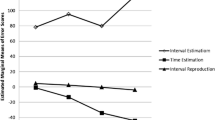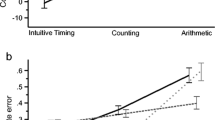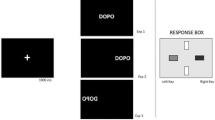Abstract
This study investigated how reasoning about conventional time information varied as a function of conventional time systems by using the Chinese month and Jieqi systems. Twenty Chinese students were asked to answer month-related questions and another 20 were asked to answer Jieqi-related questions. Reaction time and accuracy were the dependent measures. A cross-boundary effect was observed in processing months, and distance and direction effects were obtained when participants judged the interval of Jieqi. These results suggested that arithmetic operations were used in Chinese reasoning about months and verbalarticulatory processes were used for the Jieqi. The effects of mode of language representation on cognition and the strategies for cross-linguistic study are discussed.
Similar content being viewed by others
References
Altarriba, J. (Ed.) (1993).Cognition and culture: A cross-cultural approach to psychology. Amsterdam: Elsevier.
Au, T. K. (1983). Chinese and English counterfactuals: The Sapir Whorf hypothesis revisited.Cognition,15, 155–187.
Au, T. K. (1984). Counterfactuals: In reply to Alfred Bloom.Cognition,17, 289–302.
Au, T. K. (1988). Language and cognition. In R. L. Schiefelbusch & L. L. Lloyd (Eds.),Language perspective: Acquisition, retardation, and intervention (2nd ed., pp. 125–146). Austin, TX: PRO-ED.
Au, T. K. (1992). Cross-linguistic research on language and cognition: Methodological challenges. In H. Chen & O. J. L. Tzeng (Eds.),Language processing in Chinese (pp. 367–381). Amsterdam: Elsevier.
Bloom, A. H. (1981).The linguistic shaping of thought: A study in the impact of language on thinking in China and the West. Hillsdale, NJ: Erlbaum.
Bloom, A. H. (1984). CautionThe words you use may affect what you say: A response to Au.Cognition,17, 275–287.
Chen, C., &Stevenson, H. W. (1988). Cross-linguistic differences in digit span of preschool children.Journal of Experimental Child Psychology,46, 150–158.
Chen, C., &Stevenson, H. W. (1995). Motivation and mathematics achievement: A comparative study of Asian-American, Caucasian-American, and East Asian high school students.Child Development,66, 1215–1234.
Chen, H.-C., &Juola, J. F. (1982). Dimensions of lexical coding in Chinese and English.Memory & Cognition,10, 216–224.
Chen, M. J. (1993). A comparison of Chinese and English language processing. In J. Altarriba (Ed.),Cognition and culture: A crosscultural approach to psychology (pp. 97–117). Amsterdam: Elsevier.
Chi, M. T. H., Feltovich, P. J., &Glaser, R. (1981). Categorization and representation of physics problems by experts and novices.Cognitive Science,5, 121–152.
Chincotta, D., &Underwood, G. (1997). Digit span and articulatory suppression: A cross-linguistic comparison.European Journal of Cognitive Psychology,9, 89–96.
Dietrich, R., &Zheng, Z. X. (1993). The ordering of words in utterance production: An integrated view of the basic principles in German and Chinese. In J. Altarriba (Ed.),Cognition and culture: A crosscultural approach to psychology (pp. 119–143). Amsterdam: Elsevier.
Eckensberger, L. H. (1973). Methodological issues of cross-cultural research in developmental psychology. In J. R. Nesselroade & H. W. Reese (Eds.),Life-span developmental psychology: Methodological issues (pp. 43–64). New York: Academic Press.
Friedman, W. J. (1983). Image and verbal processes in reasoning about the months of the year.Journal of Experimental Psychology: Learning, Memory, & Cognition,9, 650–666.
Friedman, W. J. (1989). The representation of temporal structure in children, adolescents and adults. In I. Levin & D. Zakay (Eds.),Time and human cognition: A life-span perspective (pp. 259–304). Amsterdam: Elsevier.
Hatano, G., Miyake, Y., &Binks, M. G. (1977). Performance of expert abacus operations.Cognition,5, 57–71.
Hatano, G., &Osawa, K. (1983). Digit memory of grand experts in abacus-derived mental calculation.Cognition,15, 95–110.
Hoosain, R. (1982). Correlation between pronunciation speed and digit span size.Perceptual & Motor Skills,55, 1128.
Hoosain, R. (1984). Experiments on digit spans in the Chinese and English languages. In H. S. R. Kao & R. Hoosain (Eds.),Psychological studies of the Chinese language (pp. 23–38). Hong Kong: Chinese Language Society of Hong Kong.
Hoosain, R. (1986). Language, orthography and cognitive processes: Chinese perspective for the SapirWhorf hypothesis.International Journal of Behavioral Development,9, 507–525.
Hoosain, R. (1991).Psycholinguistic implications for linguistic relativity: A case study of Chinese. Hillsdale, NJ: Erlbaum.
Huang, W. (1993). A model of Chinese adults reasoning about the months of the year.Psychological Science (China),15, 84–89.
Hue, C.-W., &Erickson, J. R. (1988). Short-term memory for Chinese characters and radicals.Memory & Cognition,16, 196–205.
Hung, D. L., &Tzeng, O. J. L. (1981). Orthographic variations and visual information processing.Psychological Bulletin,90, 377–414.
Jiang, T., & Fang, G. (1995, August).Cognitive development of conventional time (week) of primary school pupils. Paper presented at the Asian-Pacific Region Psychological Conference, Guongzhou, China.
Kelly, M. K., Miller, K. F., Fang, G., &Feng, G. (1999). When days are numbered: Calendar structure and the development of calendar processing in English and Chinese.Journal of Experimental Child Psychology,73, 289–314.
Larkin, J. H., McDermott, J., Simon, D. P., &Simon, H. A. (1980, June). Expert and novice performance in solving physics problems.Science,208, 1335–1342.
Miller, K. F., &Paredes, D. (1996). On the shoulders of giants: Cultural tools and mathematical development. In R. Sternberg & T. Ben-Zeev (Eds.),The nature of mathematical thinking (pp. 83–117). Hillsdale, NJ: Erlbaum.
Miller, K. F., Smith, C. M., Zhu, J., &Zhang, H. (1995). Preschool origins of cross-national differences in mathematical competence: The role of number-naming systems.Psychological Science,6, 56–60.
Miller, K. F., &Stigler, J. W. (1987). Counting in Chinese: Cultural variation in a basic cognitive skill.Cognitive Development,2, 279–305.
Miller, K. F., &Zhu, J. (1991). The trouble with teens: Accessing the structure of number names.Journal of Memory & Language,30, 48–68.
Miura, I. T., Kim, C. C., Chang, C. M., &Okamoto, Y. (1988). Effects of language characteristics on childrens cognitive representation of number: Cross-national comparisons.Child Development,59, 1445–1450.
Miura, I. T., Okamoto, Y., Kim, C. C., Chang, C. M., Steere, M., &Fayol, M. (1994). Comparisons of childrens cognitive representation of number: China, France, Japan, Korea, Sweden, and the United States.International Journal of Behavioral Development,17, 401–411.
Parise, F. (Ed.) (1982).The book of calendars. New York: Facts on File.
Saxe, G. B. (1982). Developing forms of arithmetical thought among the Oksapmin of Papua New Guinea.Developmental Psychology,18, 583–594.
Saxe, G. B. (1985). Effects of schooling on arithmetical understandings: Studies with Oksapmin children in Papua New Guinea.Journal of Educational Psychology,77, 503–513.
Stevenson, H. W., Chen, C., &Lee, S. Y. (1993, January). Mathematics achievement of Chinese, Japanese, and American children: Ten years later.Science,259, 53–58.
Stigler, J. W. (1984). Mental abacus: The effect of abacus training on Chinese childrens mental calculation.Cognitive Psychology,16, 145–176.
Stigler, J. W., Lee, S. Y., &Stevenson, H. W. (1986). Digit memory in Chinese and English: Evidence for a temporally limited store.Cognition,23, 1–20.
Author information
Authors and Affiliations
Corresponding author
Additional information
This research was supported by the National Natural Science Foundation of China (39470247). The study also received the 1997 APS Student Caucus Research Competition Award.
Rights and permissions
About this article
Cite this article
Huang, W. Reasoning about conventional time as a function of conventional time systems. Mem Cogn 27, 1080–1086 (1999). https://doi.org/10.3758/BF03201237
Received:
Accepted:
Published:
Issue Date:
DOI: https://doi.org/10.3758/BF03201237




